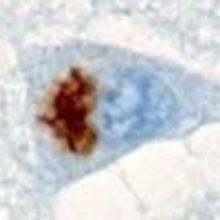Login
Subscribecell & molecular biology, genetics & genomics

Lucrative Prize for Life Scientists
Dan Cossins | Feb 20, 2013 | 2 min read
Three Silicon Valley entrepreneurs are offering $3 million to scientists demonstrating excellence in biology and medical research.

Mitochondria Versus Nucleus
Juliet Ash | Feb 15, 2013 | 3 min read
Disruptions in the interaction between nuclear and mitochondrial DNA can lead to deficiencies in the mitochondrial energy-generating process, affecting fitness.

Non-coding Repeats Cause Peptide Clumps
Ruth Williams | Feb 7, 2013 | 3 min read
Protein aggregates in the brains of some people with dementia or motor neuron disease have a surprising origin.

Fair Flu Viruses Closely Matched
Dan Cossins | Oct 29, 2012 | 1 min read
A study finds that the genomes of swine and human flu viruses associated with a county fair in Ohio are almost perfectly matched, suggesting interspecies transmission.

mRNA Not Equal in All Cells
Dan Cossins | Oct 25, 2012 | 2 min read
Scientists identify a false assumption of standard gene expression analyses that could lead to the reappraisal of many prior studies.

Eggs Trade Genes
Ruth Williams | Oct 24, 2012 | 3 min read
Swapping chromosomes from one human egg to another could eliminate mitochondrial DNA mutations that cause disease.
Salmonella Strain Spreads Alongside HIV
Dan Cossins | Oct 1, 2012 | 2 min read
Researchers find that a deadly bacterial disease hitchhikes in people infected with the virus that causes AIDS to spread throughout sub-Saharan Africa.
Best Places to Work Academia, 2012
The Scientist | Aug 1, 2012 | 9 min read
On the 10th anniversary of The Scientist’s survey of life science academics, institutions are contending with tighter budgets and larger administrative staffs, while working to sustain and inspire their researchers.
Modeling the Cell
Jef Akst | Jul 23, 2012 | 2 min read
The first full computer model of a single-celled organism mimics the bacterium’s behaviors and paves the way to more complete disease models.
Microbial Perfume
Edyta Zielinska | Jul 23, 2012 | 1 min read
Rather than rely on plant-derived products, biotech companies are engineering bacteria and yeast to produce ingredients for fragrances.
Move Over, Mother Nature
Amber Dance | Jul 1, 2012 | 8 min read
Synthetic biologists harness software to design genes and networks.
Book Excerpt from The Violinist's Thumb: And Other Lost Tales of Love, War, and Genius, As Written By Our Genetic Code
Sam Kean | Jun 30, 2012 | 3 min read
In Chapter , "Genes, Freaks, DNA," author Sam Kean draws parallels between the lives of Gregor Mendel and Johannes Friedrich Miescher, who both made scientific discoveries that were truly ahead of their times.
Six Threats to Chromosomes
Ed Yong | May 3, 2012 | 3 min read
Researchers identify two new DNA repair systems, in addition to four that were already known, that can attack unprotected telomeres.
Lab Studies Lie about the Clock
Megan Scudellari | Apr 4, 2012 | 3 min read
Fly circadian behavior is dramatically different in natural environments than in the lab.
Debate over RNA Transcription
Edyta Zielinska | Mar 19, 2012 | 1 min read
Researchers question earlier findings of a new mechanism for gene regulation.
Gain a Chromosome and Adapt
Sabrina Richards | Jan 29, 2012 | 3 min read
Research in yeast shows that aneuploidy is both a consequence of and an adaptation to stress.
Marooned Chromosomes Cause Cancer?
Edyta Zielinska | Jan 23, 2012 | 1 min read
Chromosomes accidentally stranded outside of the nucleus could contribute to cancer formation.
2011's Best and Brightest
The Scientist | Jan 1, 2012 | 1 min read
In its brief, 4-year history, The Scientist’s annual Top 10 Innovations contest has become a showcase of the coolest life science tools to emerge in the previous year.
Top Ten Innovations 2011
The Scientist | Jan 1, 2012 | 10+ min read
Our list of the best and brightest products that 2011 had to offer the life scientist
Arsenic Bug's Genome Sequenced
Bob Grant | Dec 7, 2011 | 1 min read
Researchers have mapped out the DNA of what some scientists claim to be an arsenic loving bacterium.